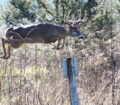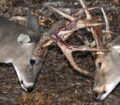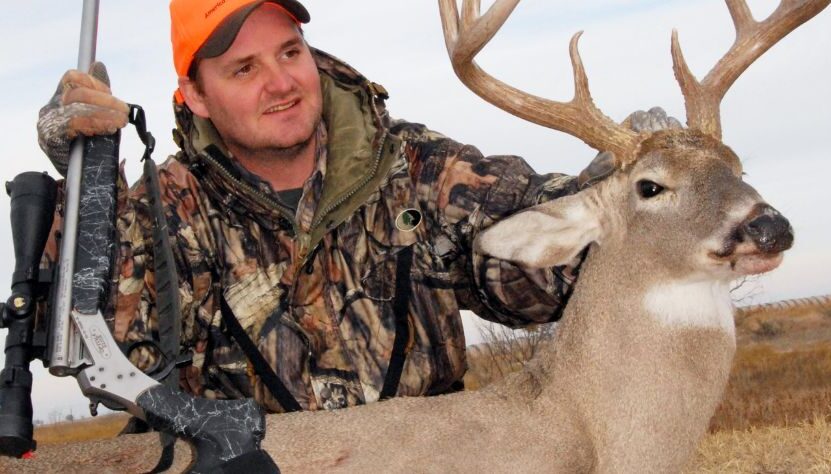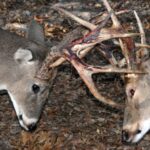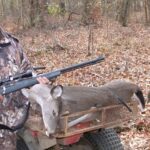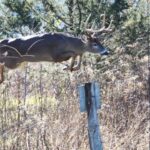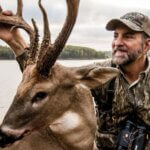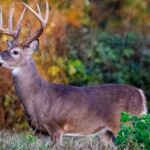Editor’s Note: Chris Kirby, owner of Quaker Boy Inc., bought his family’s business that was started in 1974 by his dad Dick Kirby, one of the legends in the calling industry. Dick Kirby was a very-versatile game caller, and Chris has followed in his footsteps, winning all the major turkey-calling championships after his dad won the World Champion of Champions, the World’s Goose Calling Championship, the World’s Moose Calling Championship, and others. Many outdoorsmen believe Chris Kirby was born with a turkey call and a deer call in his mouth because he can’t remember when he wasn’t calling critters. I’ve asked Kirby to tell us what he says to deer from the beginning of bow season until the end of rifle season to give you ideas for next year’s deer season. One of the best ways to learn a new technique or try a new product is to use it after deer season. If you’ve never attempted to call deer, leave your bow or gun at home, take some deer calls into the woods, and see what happens. Chris Kirby believes that if you’re a deer hunter, you’re a deer hunter all year.
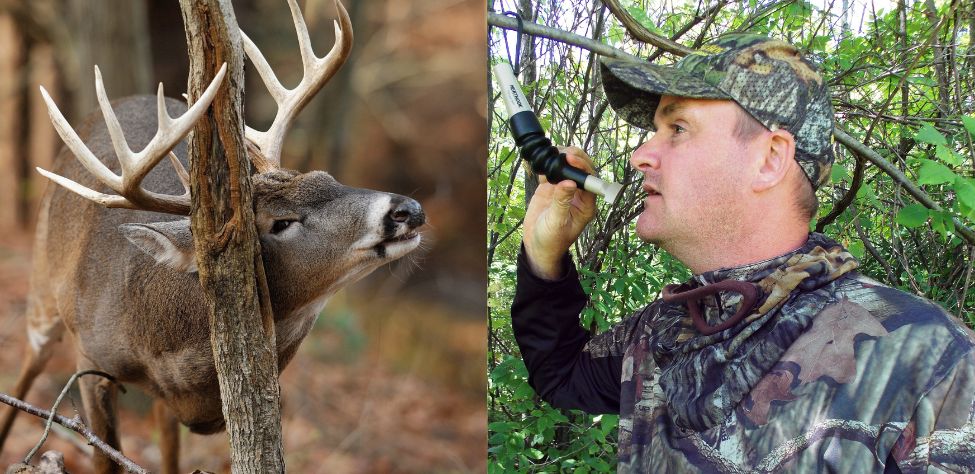
John E. Phillip: Chris, how will you call in bucks during the pre-rut?
Chris Kirby: the pre-rut is when deer calls are highly effective. The bucks’ necks are starting to swell up, the bucks’ hormone levels are starting to kick in, the adult does may start pushing the buck fawns away from them, and the rut (the time of year when the does will be receptive to being breed by the bucks) is about to occur. At this time of the year, bucks will start working their scrapes and rubs, leaving their scent in these areas to notify the does, “Hey, I’m here, and I’ll be back in a little while. If you’ll stay near this rub or this scrape when I see you, we’ll go out for a date.”
When I search for rubs or scrape lines, I don’t search for the obvious ones you see on the edges of the fields. Most of the time, those rubs and scrapes are only worked by does at night. Instead, I look for rubs or scrape lines in the woods, away from the field.
Once I find those rub or scrape lines way back in the woods, that’s where I’ll set up to start calling. I’ll be using my Quaker Boy Brawler Grunt Call, which is a bit bigger than other grunt calls. I like it because not only can I blow tending grunt calls out of it, but I also can give the big roar-style calls and get more volume out of those calls than I can with more minor grunt calls. I like to give many tending grunt calls that are more rapid and sound like blurp, blurp, blurp, which sounds like a buck chasing a doe. I may also rattle my antlers in between those tending buck calls.
Our Brawler Buck Grunt is built like a buck. Like a big buck’s chest, the mouthpiece carries some weight. The revolutionary “Trake Tube” is constructed to mimic a buck’s trachea. The rigid, reverse cone on the end resembles the mouth of a buck. These three attributes produce the most realistic buck grunts ever. Young or old, loud or soft, tending to be aggressive, the revolutionary Brawler is the most advanced grunt call ever developed.
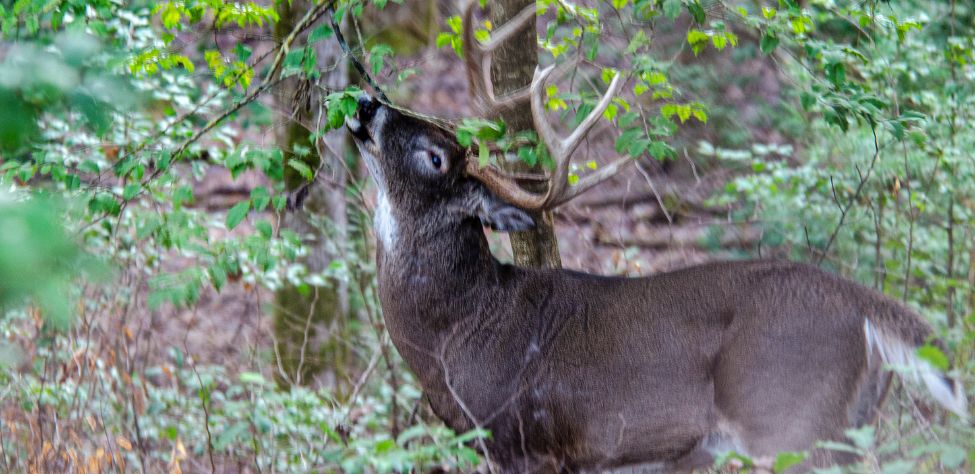
When hunting in Texas during the pre-rut, I’ll do much more rattling than I will when hunting in the East. In the Northeast, I’ll do more grunt calls and bleat calls because those places usually have higher doe-to-buck ratios than most places in Texas. In Texas, I’ll rattle a lot. In that pre-rut time, regardless of where you hunt, I suggest you occasionally use rattling antlers where you’re giving grunt and bleat calls. In the Midwest, I do a lot of calling because you’re often hunting in a big open country where the deer move a lot in daylight hours.
During the spring of the year, when hunting turkeys, I often find rubs and scrapes deep in the woods. When I discover places with three or four years’ worth of rubs or scrapes, I call them generational rubs and scrapes. They are used every year by the bucks that live in that area. Then I’ll know that buck deer have rubbed or scraped those spots for years. This is critical information that I try and store in my memory as places I’ll probably try and hunt during the next deer season. Those are areas that I may start calling in the pre-rut.
Looking for more content? Check out our YouTube channel and watch “Bob Sheppard’s Favorite Tree Stand” by John E. Phillips.

How to Hunt and Take Big Buck Deer on Small Properties
In this book, you’ll hear from 14 hunters who either have gained permission or leased properties as small as six acres to as much as 250 acres, and how they consistently take older-age-class bucks off these little lands.
VERSIONS: AUDIBLE, KINDLE & PRINT

Jim Crumley’s Secrets of Bowhunting Deer
Using a black magic marker and a gray work jumpsuit, Jim Crumley of Buchanan, Virginia, drastically changed the nature and purpose of hunting camouflage when he created the first sportsman’s camouflage – Trebark. Crumley’s love of bowhunting and his desire to be more invisible changed hunting clothing forever.
In this hunting guide, he shares the wisdom that he’s learned throughout his lifetime about how to be a hunter, how to find a deer lease, how to scout for deer, and more.
Special features include how to:
- Have a magic 60 acres to hunt
- Decide the best equipment to use
- Find deer year-round
- Locate land to hunt
- Know the best place to put your tree stand
- Get bucks within bow range
VERSIONS: AUDIBLE, KINDLE & PRINT

How to Hunt Deer Like a Pro
How do you know if the land you hunt has a trophy deer on it? Wildlife manager Bob Zaiglin, of Uvalde, Texas and Jim Crumley, the father of modern-day hunting camouflage, tells you how to find out. GPS can make finding and taking that trophy buck easier. This hunting guide will teach you how to hunt big bucks where no one else can find them, how to call deer, and how to become versatile as a deer hunter, so that if one deer tactic doesn’t work, another one will.
In the chapter, “How to find Bucks at Scrape,” Dr. Keith Causey, retired professor of Wildlife Science at Auburn University, describes the best way to hunt a scrape.
Brad Harrison of Neosho, Missouri, is a nationally-known videographer, professional deer hunter and master at calling deer. Another master is Will Primos of Primos Game Calls. These two experts will tell the best deer calls and when to use them in this book.
And for over 20 years, Bo Pitman, lodge manager of White Oak Plantation, has been studying deer movement patterns. He explains what types of conditions are best for predicting deer movement.
VERSIONS: AUDIBLE, KINDLE & PRINT

Deer hunting and deer hunters are drastically changing each year. To learn new techniques for hunting deer and have more places to hunt, I’ve interviewed some of the best deer hunters in the nation and share their tactics in How to Hunt Deer Like a Pro: Volume II.
In Chapter 10, Jacob Lamar tells you his tactics for consistently taking older-age-class bucks on public lands in several states. Chapter 11, Bob Walker explains how to find places on public lands where you can hunt that 99 percent of the other hunters never have considered hunting. The Bonus Chapter with David Ramey tells you how, where, when and with what equipment to take big Kansas bucks on public lands by hunting in 100-degree weather when others won’t hunt.
Chapter 13, Mark Drury, his family and his guests take mature bucks every season by having more small places to hunt rather than one large property. Drury explains the strategy of having satellite farms to hunt that only may be 50-150 acres each or less. Chapter 15, Pat Reeve, who hunts far-northern states and Canada, says, “I don’t like hunting for mature bucks until the weather is 20 degrees or less.” Chapter 4, Dr. Larry Marchinton says that funnels are the most-reliable stand sites to hunt for big bucks and tells why.
VERSIONS: AUDIBLE & PRINT
Tomorrow: Call Deer During the Rut’s Peak

